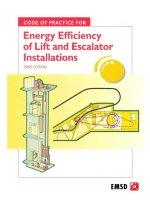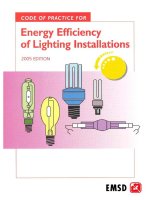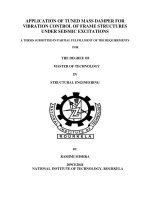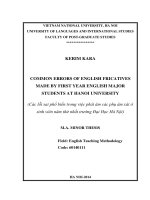Genotypic variation for phosphorus efficiency of pigeonpea genotypes under varied phosphorus levels - Trường Đại học Công nghiệp Thực phẩm Tp. Hồ Chí Minh
Bạn đang xem bản rút gọn của tài liệu. Xem và tải ngay bản đầy đủ của tài liệu tại đây (171.05 KB, 7 trang )
<span class='text_page_counter'>(1)</span><div class='page_container' data-page=1>
<i><b>Int.J.Curr.Microbiol.App.Sci </b></i><b>(2017)</b><i><b> 6</b></i><b>(11): 3633-3647 </b>
3633
<b>Original Research Article </b>
<b>Genotypic Variation for Phosphorus Efficiency of Pigeonpea </b>
<b>Genotypes under Varied Phosphorus Levels </b>
<b>Sukhpreet Kaur Sidhu1*, Jagmeet Kaur2 and Satvir Kaur Grewal3</b>
1
Department of Botany, Punjab Agricultural University, Ludhiana 141004, Punjab, India
2
Department of Plant Breeding and Genetics, Punjab Agricultural University,
Ludhiana 141004, Punjab, India
3
Department of Biochemistry, Punjab Agricultural University, Ludhiana 141004, Punjab, India
<i>*Corresponding author </i>
<i><b> </b></i> <i><b> A B S T R A C T </b></i>
<i><b> </b></i>
<b>Introduction </b>
Phosphorus (P) plays vital role in every phase
of plant growth and development. It is a
fundamental structural constituent of
coenzymes, phosphoproteins, phospholipids
and sugar phosphates (Veneklaas <i>et al., </i>
2012). Phosphorus uptake by the roots from
the soil solution is as phosphate ions (HPO4-2
and H2PO4-) moreover, some soluble organic
phosphorus compounds are also absorbed
(Rubya and Md, 2016). Phosphorus never
found as a free state in soil, it forms
complexes with several cations such as Fe,
Ca, Mg and Al. Phosphorus is a
non-renewable because the phosphate rich rocks
are formed slowly (Clemens <i>et al., </i>2016). It
has been hypothesized that rock phosphate
will exhaust in 2033-34 years and then
production of fertilizers reduced and the
prices are expected to rise (Cordell <i>et al., </i>
2009). Phosphorus fertilizers due to hike in
prices as well as environmental contaminants
need to be replaced with safe and economical
<i>International Journal of Current Microbiology and Applied Sciences </i>
<i><b>ISSN: 2319-7706</b></i><b> Volume 6 Number 11 (2017) pp. 3633-3647 </b>
Journal homepage:
Enhancement in phosphorus (P) efficiency of crop plants require a better understanding of
alterations in root architecture phenes and physio-biochemical processes under phosphorus
deprived condition. This study analyzed the morpho-physiological and biochemical
alterations associated with P efficiency of crop. Six pigeonpea [Cajanus cajan (L.) Millsp]
genotypes (AL1758, AL1817, AL201, H005, ICPL93081, and ICPL88039) were tested
under two P treatments [P fertilizer not added in soil and recommended dose of P (Single
Super phosphate @ 250kg/ ha)]. Phosphorous use efficient pigeonpea genotypes have
ability to take immobile P from P deprived conditions by modifying root architecture.
Roots of these P use efficient genotypes syntheses and secrete enzyme i.e acid phosphatase
(APase) in rhizosphere which solubilize the organic P of soil and make it available to plant
uptake. Genotypes such as H005, ICPL88039 and ICPL93081 exhibited 8.6%, 6.9% and
1.8% increase in root area under no added P condition, respectively. The activity of APase
enzyme was recorded highest in P use efficient genotypes under P not added condition at
all growth stages while less enzyme activity was determined in these genotypes under P
recommend dose condition. It revealed that these pigeonpea genotype syntheses more
APase to mobilize the unavailable form of soil P.
<b>K e y w o r d s </b>
Root traits, Acid
phosphtase activity, P
content, Anatomy of
lateral root, Yield.
<i><b>Accepted: </b></i>
26 September 2017
</div>
<span class='text_page_counter'>(2)</span><div class='page_container' data-page=2>
<i><b>Int.J.Curr.Microbiol.App.Sci </b></i><b>(2017)</b><i><b> 6</b></i><b>(11): 3633-3647 </b>
3634
alternatives, P use efficient genotypes can
help to reduce the use of fertilizer.
Pigeonpea is one of the chief protein rich
legume crop belongs to <i>Fabaceae</i> family. The
shoots of pigeonpea are used as fuel and seeds
can be eaten as <i>dahl</i>. The leaves and seed
pods are used to feed livestock. Ability of
crop to resist drought and fix nitrogen in soil
makes it good choice for rainfed and irrigated
areas. Pigeonpea occupied total area of 3.9
million hectare with production of 3.2 million
tonnes during 2013-2014 in India
(INDIASTAT, 2015). Some of the pigeonpea
genotypes have ability to uptake more P with
enhanced activity of root acid phosphatase
and by developing some specific
physiological mechanisms under P deficient
conditions (Krishnappa and Hussain, 2014).
Phosphorus acquisition from the soil depends
on root architecture phenes. Root architecture
is highly flexible trait adapted according to
soil environment and varies among crop
species. Its flexibility is controlled by growth
substances, expression of P transporters and
heritable genes. Modifications in root
morphology under P deficient soil condition
are associated with phytohormone
concentration. Several studies have implicated
that localized phytohormone concentration,
transmission of hormonal signals and sugar
demonstrate considerable role in root growth
during P deficiency (Karthikeyan <i>et al., </i>
2007). Plants have developed various
adaptive strategies for better acquisition and
utilization of P (Lambers <i>et al., </i> 2006).
Phosphorus accumulation increased due to
higher P uptake efficiency, which can be
linked to superior root character like high root
area, root biomass, root length, root volume
and altered plant metabolism like organic acid
exudation and root acid phosphatase activity
in P use efficient genotypes play a crucial role
in supporting plants to more acquisition of P
under P deficient soil conditions (Krishnappa
<i>et al., </i>2011). Some genes of plants activated
in low P fertility soil but the function of these
genes were lost when plants grown in high
input -P conditions (Wissuwa <i>et al., </i>2009).
In soil supplied with fertilizers, P availability
higher in top layers of soil. Crop plants with
better root traits (more root surface area,
hairs, branching and volume) are more
capable to acquire P from top soil (Manschadi
<i>et al., </i>2013). Root characters <i>i.e.,</i> root length,
fineness, surface area and root hair density
affected by the behavior of plant in P
deficient soils (Rao <i>et al., </i>1996).
</div>
<span class='text_page_counter'>(3)</span><div class='page_container' data-page=3>
<i><b>Int.J.Curr.Microbiol.App.Sci </b></i><b>(2017)</b><i><b> 6</b></i><b>(11): 3633-3647 </b>
3635
important adaptive traits such as alternation in
root characteristics, exudation of organic
acids, change in the rhizosphere pH and
increased capacity of roots to explore various
layers of soil (Schachtman <i>et al., </i>1998).
Plants have developed other strategies for P
uptake and utilization in P limiting
environment that include: remobilization of
internal inorganic phosphate, symbioses
(mycorrhizal), more synthesis and release of
root enzyme phosphatases, exudation of
organic acids, and modification of root
architecture (Plaxton, 2004). Acid
phosphatase mobilizes organically bound P by
catalysing hydrolytic cleavage of the C-O-P
ester bond in soil and release inorganic P to
plants. Cellular reallocation of P by acid
phosphatases in crops was also investigated
(Wang <i>et al., </i>2010). Plants have ability to
alter various mechanisms to ameliorate their P
acquisition (root architecture, angles,
symbiosis and exudates) and allocation of P
within plant (Clemens <i>et al., </i> 2016).
Acquisition of applied P from soil by plants
depends on root architecture. Plants have
developed new properties for efficient use of
available soil P and to mobilize P from less
available soil P fractions. The adaptive
properties developed by plants in response to
P availability are the alteration of their root
morphology. Therefore, the present
investigation was undertaken to examine the
morpho-physiological and biochemical
alterations in different parts of pigeonpea
genotypes at growth various stages.
<b>Materials and Methods </b>
<b>Location of experiment and field layout</b>
The experiment was conducted in the
experimental area of the Pulse section,
Department of Plant Breeding and Genetics,
Punjab Agricultural University, Ludhiana
during <i>Kharif </i>2016. Ludhiana represents the
Indo-Gangetic alluvial plains, situated at
30°-54'N latitude, 75°-48'E longitude and at an
altitude of 247 m above mean sea level.
Ludhiana is positioned in South-Central plain
region of Punjab having subtropical and
semi-arid climate. Pre planting soil analysis was
carried out and samples of the soil were
collected randomly at depth of 0-15 cm from
the experimental area were randomly selected
from five places at the start of the experiment
to determine the physicochemical properties
of the soil. The soil of the experimental area
was loamy sand with organic C (0.241%), pH
of ~7.4, available P (9.8 kg/ acre) and
potassium (75 kg/ acre). Six pigeonpea
genotypes namely AL1758, AL1817, AL201,
H005, ICPL93081, ICPL88039 were sown
with two treatments [P fertilizer not added in
soil and recommended dose of P (40 kg/ha)]
and three replications in the field. Seeds of
these genotypes were procured from
International Crops Research Institute for the
Semi-Arid Tropics (ICRISAT) and
Agricultural University of Punjab (PAU). The
plot consisted of four rows, each of four meter
length with a row to row distance 50 cm and
plant to plant 25 cm. Experimental design was
randomized block design and the crop was
sown as recommended by Package of
Practices for <i>Kharif</i> crops, PAU, Ludhiana
(2015). Morpho-physiological and
biochemical parameters were recorded at
vegetative, flower initiation and pod filling
stages.
<b>Morpho- physiological parameters </b>
</div>
<span class='text_page_counter'>(4)</span><div class='page_container' data-page=4>
<i><b>Int.J.Curr.Microbiol.App.Sci </b></i><b>(2017)</b><i><b> 6</b></i><b>(11): 3633-3647 </b>
3636
for 48 hrs at 60° C and used for specific leaf
weight (mg cm-2 plant-1) determined by
following formula:
Leaf dry weight (mg)
Specific Leaf weight (SLW) = ---
Leaf Area (cm2)
Above ground plant biomass were recorded
after drying the plants in an oven at 70±1°C
for 48 hr and plant biomass was expressed in
g plant-1. Root shoot ratio calculated as the
ratio between root dry weight and shoot dry
weight. Photosynthetic rate and internal CO2
concentration were measured by using
portable infra-red gas analyser (LI-6400XT,
LICOR). Rate of photosynthesis is expressed
as μmol CO2
m-2 s-1. A LED light source
attached to leaf chamber and 1500 μ mol m-2
s-1 a saturating photosynthetically active
radiation (PAR) was supplied. The
photosynthetic rate was measured of third
trifoliate leaf from top.
<b>Biochemical analysis </b>
Fresh root samples were used for the
estimation of acid phosphatase enzyme
(APase) activity (Kouas <i>et al.,</i> 2009). Root
tissue 0.1g was homogenized in a chilled
glass mortar with a pestle. The extraction
buffer containing 0.1M acetate buffer (7.4),
6mM β-mercaptoethanol, 6g
polyvinyl-polypyrolidone and 0.1mM phenyl methyl
sulfonyl fluoride was used. The homogenate
was centrifuged at 30000 rpm for 30 minutes
at 4oC. Supernatant was used for estimating
the activity of acid phosphatase. The reaction
mixture contained 100 mM sodium acetate
buffer (pH 5.8), 5mM <i>p</i>
-nitrophenylphosphate and 50 µl of enzyme
extract was incubated at 37oC for 20 minutes.
The solution was then made alkaline with 1
ml 0.5 M NaOH to stop the reaction and
optical density of yellow colored product <i>i.e </i>
<i>p</i>-nitrophenol was recorded at 405 nm. A
standard curve was also prepared
simultaneously using graded concentration of
<i>p</i>- nitrophenol. Enzyme activity was
expressed as µ moles of <i>p</i>- nitophenol min-1 g
-1
. The P content in root, stem and leaf was
estimated by vanado-molybdate method
(Jackson, 1973).
<b>Native polyacrylamide gel electrophorsis for </b>
<b>acid phosphatase </b>
Proteins from root tissues of pigeonpea
cultivars were extracted in 1 ml of 25 mM
sodium phosphate buffer (pH 7.5) containing
1% PVP, the tissue was ground in pestle and
mortar. The homogenized tissue was
centrifuged in a cooling centrifuge at 4±1 oC
for 20 min at 10,000 rpm. Supernatant was
collected as crude protein sample and stored
at 4±1 oC. 40 µg proteins from root, per lane,
were loaded into native polyacrylamide gel
(7.5% w/v stacking gel and 10% w/v
resolving gel). Electrophoresis was carried
out at constant voltage of 50 V until the
samples travel through stacking gel after that
voltage was increased to 70 V. The native
gels were run at low temperature (4±10C).
After completion of the electrophoresis, gels
were washed three times in 0.1 mM sodium
acetate buffer (pH 5.0) and acid phosphatase
activity was stained with 0.2 % diazo dye and
0.2% p-nitrophenyl phosphate. Dark brown
coloured bands of acid phosphatase (APases)
were appeared after 40 minutes (Ciereszko <i>et </i>
<i>al., </i>2011) with little modification for staining.
<b>Lateral root anatomy </b>
</div>
<span class='text_page_counter'>(5)</span><div class='page_container' data-page=5>
<i><b>Int.J.Curr.Microbiol.App.Sci </b></i><b>(2017)</b><i><b> 6</b></i><b>(11): 3633-3647 </b>
3637
alcohol. The embedding of lateral root
material was undertaken in paraffin wax and
small wax blocks of the embedded material
were mounted on a wooden block for
microtomy. Serial sections of the roots were
cut on a rotary microtome at 10 μm thickness.
Before staining, the slides were dewaxed by
using xylene. Root sections were hydrated
using downward series of xylene: alcohol
(3:1, 1:1, 1:3) and alcohol (absolute, 95, 70,
50, 30 and 10%) series. Then slides were
stained with erythrosine. Image analysis was
performed with ImageJ 1.51J8 software.
<b>Yield and yield attributes </b>
Yield was recorded at harvest from randomly
selected five plants from each replicated plot.
All the plants from each plot were sun dried
for 2-3 days. Grain yield was recorded on the
basis of plot and then converted into kg ha-1.
<b>Statistical analysis </b>
The data were subject to analysis of variance
(ANOVA) in a randomized complete block
design as per the standard procedures. Critical
difference values at 5% level of significance
were calculated to compare mean values by
CPCS-1 software.
<b>Results and Discussion</b>
Plant height increased gradually with crop
developmental stages. At vegetative stage tallest
plants were observed in AL201 while shortest
in AL1758 under no P added condition (-P) and
AL201 attained maximum plant height
followed by AL1817 at pod filing stage (Table
1). The decrease of plant height of genotypes
grown under no P added was accompanied by
a decrease in plant biomass. At pod filing
stage ICPL88039 accumulated significantly
more biomass followed by H005 and AL201
under recommended dose of P condition (+P).
No significant differences were observed
</div>
<span class='text_page_counter'>(6)</span><div class='page_container' data-page=6>
<i><b>Int.J.Curr.Microbiol.App.Sci </b></i><b>(2017)</b><i><b> 6</b></i><b>(11): 3633-3647 </b>
3638
in plants (Vandamme <i>et al., </i>2016, Hammond
and White, 2011).
<b>Photosynthetic rate and internal CO2</b>
<b>concentration </b>
Our results of photosynthetic efficiency
demonstrated that genotypes grown under no
added P showed 1.2% and 2.2% increase at
vegetative and flower initiation phase. It
revealed that P efficient genotypes maintained
photosynthesis under P limited conditions.
Net photosynthesis efficiency increased from
vegetative to flowering stage and then
declined towards maturity. Under no added P
condition, maximum photosynthesis rate was
recorded in ICPL88039 followed by H005
and ICPL93081 at flowering stage (Table 3).
Internal CO2 concentration (Ci) followed a
similar trend as the photosynthesis rate. The
reduction of Ci was higher in P use non
efficient genotypes than in P use efficient
(Table 3). Difference between mean values of
genotypes for photosynthesis efficiency and
Ci was significant at all stages. The biomass
production and yield of crops are largely
dependent on photosynthesis. Inhibition of
photosynthesis by P limitation has often been
explained by depressing the Calvin cycle
activity, in particular, by depressing the
amount and activity of Rubisco and the
regeneration of Ribulose-1,5-bisphosphate
(Lauer <i>et al., </i> 1989). Photosynthesis is the
most important photochemical sink for energy
absorbed by leaves, and therefore the
photosynthetic apparatus is liable to be
exposed to harmful excess light energy due
the strong CO 2 assimilation inhibition in
plants evoked by P deficiency (Richardson <i>et </i>
<i>al., </i>2011; Veronica <i>et al., </i>2016).
<b>Root acid phosphatase activity </b>
An acid phosphatase activity was recorded
lower in genotypes namely AL1817 and
AL1758 under both P treatments than other
genotypes at all stages (Fig. 4). At vegetative
and flower initiation stage 23.0 and 20.9 fold
increase in APase activity was recorded under
–P over +P condition, respectively. The acid
phosphatase activity in root of ICPL93081,
H005 and ICPL88039 under no added P was
29.0, 11.3 and 10.8 fold higher than the
recommended P dose condition at vegetative
stage. Maximum activity of enzyme in all
genotypes was observed under no added P
than P recommended dose condition. It
revealed that low P condition stimulate the
root to syntheses and secrete more APase in
soil to mobilize the unavailable form of P. In
pigeonpea, root acid phosphatase activity of
high P uptake genotypes was 74.88 %
increased under P deficient condition as
compared to P sufficient condition
(Krishnappa and Hussain, 2014). Acid
phosphatase activity is not constant in plants;
it changes according to soil environment
condition. In low P soil microenvironment,
genes related to P solubilizing enzymes such
as acid phosphatase and high affinity P
transporters are upregulated for P uptake
(Clemen<i>s et al., </i>2016).
<b>Native polyacrylamide gel electrophorsis </b>
<b>for root acid phosphatase </b>
</div>
<span class='text_page_counter'>(7)</span><div class='page_container' data-page=7>
<i><b>Int.J.Curr.Microbiol.App.Sci </b></i><b>(2017)</b><i><b> 6</b></i><b>(11): 3633-3647 </b>
3639
<b>Table.1 </b>Plant height (cm) of pigeonpea genotypes at various growth stages
under + P and –P conditions
<b>Table.2 </b>Number of branches and biomass of pigeonpea genotypes at various growth stages
under + P and –P conditions
<b>Table.3 </b>Photosynthetic rate and internal CO concentration of pigeonpea genotypes at various
growth stages under + P and –P conditions
<b> Genotypes </b>
<b> </b>
<b>Photosynthesis rate (µ mol CO2 /m2/s) </b> <b>Internal CO2 concentration (ppm) </b>
<b>Vegetative </b> <b>Flower initiation </b> <b>Pod filling </b> <b>Vegetative </b> <b>Flower initiation </b> <b>Pod filling </b>
<b>+P </b> <b>-P </b> <b>+P </b> <b>-P </b> <b>+P </b> <b>-P </b> <b>+P </b> <b>-P </b> <b>+P </b> <b>-P </b> <b>+P </b> <b>-P </b>
AL1817 2.78 2.57 9.74 8.63 4.53 4.35 165.7 157.7 198.0 192.3 178.7 171.7
AL201 2.85 2.78 11.50 10.12 5.43 4.83 144.3 140.0 188.0 183.0 152.3 142.3
AL1758 2.75 2.69 8.80 7.76 5.54 5.34 143.0 139.3 184.7 181.3 176.0 173.7
H005 3.55 3.75 11.25 14.47 6.33 6.20 168.0 170.3 204.3 211.3 193.7 197.3
ICPL93081 3.72 3.88 11.14 11.93 5.73 5.77 169.3 172.0 201.0 209.0 192.3 196.0
ICPL88039 3.95 4.18 14.73 15.73 7.67 7.83 183.3 190.7 212.3 223.0 201.7 207.0
CD (5%) NS 0.99 NS 4.95 1.54 1.53 12.05 11.80 12.20 13.77 10.13 7.76
<b>Table.4 </b>Xylem vessel characteristics of two pigeonpea genotypes
Genotypes Number
of small
xylem
vessels
Number of
large
metaxylem
vessels
Range of
vessel
diameter
(mm)
Average size
of xylem
vessels (mm)
Standard
deviation
Diameter
of root
section
(mm)
Average area
of small and
large xylem
vessels
ICPL88039 50 10 0.29-0.129 0.060 13.312 0.742 4.80E-05
AL1758 25 19 0.25-0.146 0.067 15.815 0.482 5.36E-05
Genotypes
Vegetative stage Flower initiation Pod filling stage
+P -P +P -P +P -P
AL1817 133.2±1.30 124.1±0.77 175.8±2.38 154.3±1.00 208.1±1.92 199.5±1.58
AL201 132.3±1.34 129.3±1.44 161.2±1.96 154.1±1.14 204.2±2.26 201.4±0.48
AL1758 126.9±1.72 121.7±1.01 155.2±1.84 145.5±0.93 194.4±0.88 191.6±1.93
H005 136.1±0.70 125.6±0.55 174.3±1.95 163.4±1.29 204.5±2.10 198.3±1.59
ICPL93081 128.6±1.49 122.3±0.79 165.5±0.95 151.8±1.69 198.2±1.51 191.2±1.49
ICPL88039 136.1±0.86 128.0±0.88 178.2±1.75 173.5±2.17 213.4±2.12 197.1±1.89
C.D (5%) NS 5.06 10.40 8.42 10.70 NS
Genotypes
<b>Number of branches</b> <b>Biomass/plant (g)</b>
Vegetative Flower initiation Pod filling Vegetative Flower initiation Pod filling
+P -P +P -P +P -P +P -P +P -P +P -P
AL1817 8 8 16 14 17 17 21.07 18.81 73.94 68.61 95.58 92.71
AL201 8 6 17 15 18 15 20.01 17.94 67.53 62.87 96.74 92.59
AL1758 5 5 14 12 22 16 21.12 19.65 67.89 64.22 86.69 83.82
H005 6 6 17 19 21 22 22.84 19.48 77.51 70.54 97.23 93.74
ICPL93081 7 7 17 19 21 21 20.21 17.74 72.50 69.03 89.52 87.36
ICPL88039 9 9 19 21 22 23 21.92 20.03 79.74 72.17 98.05 97.32
</div>
<!--links-->
Tạp chí Khoa học và Phát triển 2009: Tập 7, số 3: 225 -231TRƯỜNG ĐẠI HỌC NÔNG NGHIỆP HÀ NỘI.NH H¦ëNG CñA VIÖC Sö DôNG PH¢N VI£N NÐN KÕT HîP VíI CHÕ PHÈM PH¢N BãN L¸ KOMIX §ÕN SINH TR¦ëNG Vμ N¡NG SUÊT GIèNG NG¤ LVN4Effect of Granulated Fertilizer Appl potx
- 7
- 675
- 1








